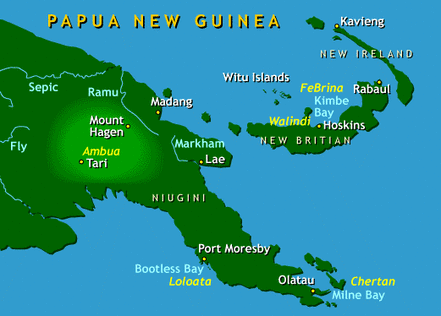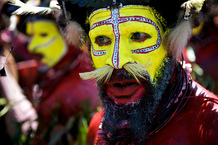
Does the tribe exist:
Yes, the Huli tribe exist and currently has a population of 65,000 people
Location:
The Huli Tribe lives in the Tari Basin in the highlands of Papua New Guinea. The region had little outside influence before the 1940s when plane travel allowed Westerners to bypass the coastal swamps and rugged inland mountains.
Reliance upon the rainforest:
To live, they hunt Yams, Manioc, sometimes meat from village raised Pigs and wild Cassowary or other forest game such as tree Kangaroos.
They also use the Rainforest to make the rounded grass huts they live in.
Threats:
The threats to a Huli Tribe are flooding, crop damage and the danger of their part of the rain forest being cut down for wood.These threats can destroy there crops and homes and deforestation causes damage because they are there is less wild animals for them to catch. They also us the grasses to build their homes.
Yes, the Huli tribe exist and currently has a population of 65,000 people
Location:
The Huli Tribe lives in the Tari Basin in the highlands of Papua New Guinea. The region had little outside influence before the 1940s when plane travel allowed Westerners to bypass the coastal swamps and rugged inland mountains.
Reliance upon the rainforest:
To live, they hunt Yams, Manioc, sometimes meat from village raised Pigs and wild Cassowary or other forest game such as tree Kangaroos.
They also use the Rainforest to make the rounded grass huts they live in.
Threats:
The threats to a Huli Tribe are flooding, crop damage and the danger of their part of the rain forest being cut down for wood.These threats can destroy there crops and homes and deforestation causes damage because they are there is less wild animals for them to catch. They also us the grasses to build their homes.
 Cuscus
Cuscus
Food:
The Huli people have a diet of yams, manioc, a plant with a large starchy root and sometimes meat from village raised pigs. Wild cassowary or other forest game, such as tree kangaroos and cuscus are also hunted and eaten by the huli people. The first Westerners to visit the highlands in the 1920s were amazed to see vast valleys of carefully planned gardens and irrigation ditches.
The Huli people have a diet of yams, manioc, a plant with a large starchy root and sometimes meat from village raised pigs. Wild cassowary or other forest game, such as tree kangaroos and cuscus are also hunted and eaten by the huli people. The first Westerners to visit the highlands in the 1920s were amazed to see vast valleys of carefully planned gardens and irrigation ditches.
Shelter:
The Huli people live in rounded grass huts. These huts are fenced by split-wood fences and mud walls. The compound walls serve a dual purpose of keeping domesticated pigs in the compound and away from the gardens while keeping enemies and evil spirits out. Traditionally, the men sleep in one hut while the women and pigs sleep in another. This practice has been discouraged by western missionaries, and today most villages keep pigs in a third hut. Villagers cover their bodies with pig-fat grease and ash to keep warm during the cold mountain mornings. At night, a small fire is kept inside the hut so that the heat - and smoke - fills the hut and keeps the occupants warm.
The Huli people live in rounded grass huts. These huts are fenced by split-wood fences and mud walls. The compound walls serve a dual purpose of keeping domesticated pigs in the compound and away from the gardens while keeping enemies and evil spirits out. Traditionally, the men sleep in one hut while the women and pigs sleep in another. This practice has been discouraged by western missionaries, and today most villages keep pigs in a third hut. Villagers cover their bodies with pig-fat grease and ash to keep warm during the cold mountain mornings. At night, a small fire is kept inside the hut so that the heat - and smoke - fills the hut and keeps the occupants warm.
Clothing:
Women wear grass skirts and traditional men wear nothing but a koteka, a garment worn to cover the man's private. Men may also wear a string apron which is wrapped around their waist. The apron is much longer which comes down to their knees and covers more of their body.
Women wear grass skirts and traditional men wear nothing but a koteka, a garment worn to cover the man's private. Men may also wear a string apron which is wrapped around their waist. The apron is much longer which comes down to their knees and covers more of their body.

Interesting Facts
- The pigs are a sign of wealth and importance, and are also used as the bride price paid to the family of a bride
- They have celebrations called sing-sings where they spend hours getting prepared where they dress up and paint their faces in bright yellow colours.
BIBLIOGRAPHY
http://www.care2.com/cards/writeups/huli.html
http://www.kidsplanet.org/factsheets/ocelot.html
http://justaboutcoffee.com/index.php?file=coffeetree
http://a-z-animals.com/animals/ocelot/
http://www.care2.com/cards/writeups/huli.html
http://www.kidsplanet.org/factsheets/ocelot.html
http://justaboutcoffee.com/index.php?file=coffeetree
http://a-z-animals.com/animals/ocelot/
